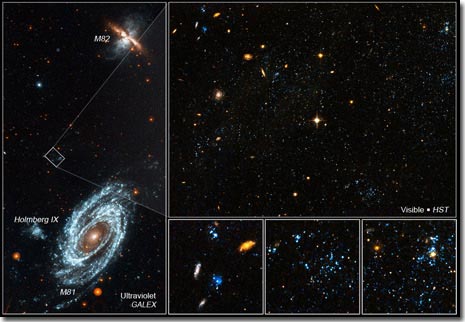Discovering 'green spots' in the universe
The green specks of light that are tens of thousands of times brighter than the sun have been discovered by the Hubble Observatory in an empty space between galaxies. They may be star clusters born in the vortices of a galaxy collision about 200 million years ago.
These mysterious star clusters are considered orphaned, because they do not belong to any particular galaxy. In fact, they clump together in a structure called Arp's Loop along a thin strip of gas stretched between three colliding galaxies - M81, M82 and NGC 3077. These galaxies are located far away from them. We have about 12 million light-years in the constellation Ursa Major.
" We can't believe it, these stars are in nothing, " said Duilia de Mello of the Catholic University in Washington, DC.
Astronomers once thought that the twisted air mass was not thick enough to accumulate enough materials needed to produce so many stars. But the new photos reveal that they contain 5 times more stars than the Orion Nebula. De Mello and colleagues speculate that clashes with galaxies and the chaos that followed may have triggered the formation of stars. The last collision of M81 and M82 occurred about 200 years ago.
And because these galaxy collisions are so common in the early universe, astronomers predict that such green spots are much more popular today.

Green spots (in squares) are found on thin strips of gas between the galaxy M81 and M82.(Photo: NASA)
T. An
- Summarize the best news of the September 4 week
- Giant black spots appeared on the sun
- What is the small green spot on Mars's surface?
- Very good discoveries about the universe are unknown (2)
- 14-year-old girl invented how to eliminate blind spots on cars
- Why do nails have white spots, the reason is simple
- The mystery of our Universe's intersection with another parallel Universe
- Black spots appear on the skin, what is the cause?
- Why do we get green tea?
- Discover the galaxy 'Green Pea'
- Strange minerals form on the remains and make the bones green
- Video: The threat of blue algae blooms in the rivers and lakes
 Van Allen's belt and evidence that the Apollo 11 mission to the Moon was myth
Van Allen's belt and evidence that the Apollo 11 mission to the Moon was myth The levels of civilization in the universe (Kardashev scale)
The levels of civilization in the universe (Kardashev scale) Today Mars, the sun and the Earth are aligned
Today Mars, the sun and the Earth are aligned The Amazon owner announced a secret plan to build a space base for thousands of people
The Amazon owner announced a secret plan to build a space base for thousands of people